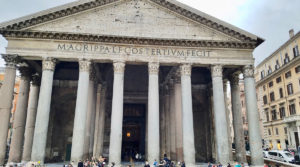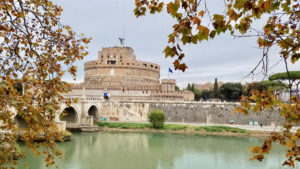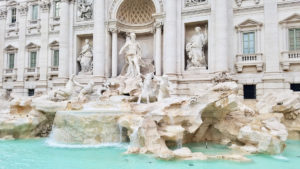Outlined below are ten (10) pieces of information that even the seasoned traveler may not know.
1.) Rome wasn’t built in a day!
While that expression is true, legend has it that one day in 753 B.C. a young man named Romulus used a plough in the soil to trace what would become the walls of his city. His twin brother Remus apparently didn’t like his plan and told Romulus in no uncertain terms. So Romulus killed his brother and built his city the way he wanted. This site was on Palatine Hill, the centermost of the Seven Hills of Rome. From this hill Rome grew to become the largest and most powerful empire of its time.
2.) The doors of the perfectly designed Pantheon were built incorrectly.
This only remaining totally preserved building of ancient Rome, the Pantheon, was built by Agrippa in 27 B.C and is considered to be the most perfectly designed structure. The very large front doors were originally made of wood and plated with gold. Sometime in the 15th Century these golden doors disappeared (what a surprise!) and needed to be replace. It seems whomever took the measurements wasn’t very capable and when the new doors, now bronze not gold, arrived on site to be installed… they were too small for the frame. Oh well… they were used anyway and have lasted over five centuries.
3.) The largest stairway in Europe, the Spanish Steps, is not on one of the famous Seven Hills of Rome.
Standing on the Pincian Hill, atop the Spanish Steps there is a marvelous vista of all Rome. For this reason, most visitors to Rome assume this hill must be one of the Seven Hills that make up the city. Actually the Pincio, as it is called in Italian, lies outside of the original boundaries of the ancient city so it is not included in the seven. However, important families of Rome did have villas and spectacular gardens on this hill. It was in the year 270 A.D. that the city limits were extended to include this area. Thus it became the eighth hill of Rome.
4.) The giant columns used for the front of the Pantheon were carved in Egypt.
 Sixteen solid granite columns support the monumental entrance to the Pantheon. Each column is 49 feet tall and weighs 60 tons. The columns were quarried in Egypt and dragged 62 miles across sand to the Nile. Here they were loaded onto barges and taken down the Nile to the sea. Near Alexandria they were transferred to sailing ships for the journey across the Mediterranean to the Roman port of Osita. There the columns were transferred back onto barges and dragged up the Tiber River all the way to Rome. Arriving, the columns were unloaded and dragged to the Pantheon construction site. Whew! And you think dragging your bags to your hotel room is tough!
Sixteen solid granite columns support the monumental entrance to the Pantheon. Each column is 49 feet tall and weighs 60 tons. The columns were quarried in Egypt and dragged 62 miles across sand to the Nile. Here they were loaded onto barges and taken down the Nile to the sea. Near Alexandria they were transferred to sailing ships for the journey across the Mediterranean to the Roman port of Osita. There the columns were transferred back onto barges and dragged up the Tiber River all the way to Rome. Arriving, the columns were unloaded and dragged to the Pantheon construction site. Whew! And you think dragging your bags to your hotel room is tough!
5.) The most venerated temple in the Forum of ancient Rome was used for wild orgies.
Today eight tall columns in the Forum still mark the site of the Temple of Saturn. This temple was the center of the annual Saturnalia celebration honoring the God Saturn. During this festival Roman social norms were overturned with wild merrymaking, gambling, drinking, sexual freedom and whatever. The Saturnalia continues today as what we now know as Carnival, or Mardi Gras.
6.) The Tiber River was used as a way to get rid of bodies.
 The Tiber River begins in central Italy and flows generally south through Tuscany and Umbria past Rome and another 25 miles to the Mediterranean Sea. The early Romans found that the easiest way to get rid of the many bodies of criminals was to just simply throw them into the river and wave goodbye.
The Tiber River begins in central Italy and flows generally south through Tuscany and Umbria past Rome and another 25 miles to the Mediterranean Sea. The early Romans found that the easiest way to get rid of the many bodies of criminals was to just simply throw them into the river and wave goodbye.
7.) The Trevi Fountain coin tossing tradition is not very old.
 The tradition of throwing three coins over your left should into the Trevi Fountain started because of a scene, supported by a hit song, in the Academy Award winning 1954 American movie Three Coin’s in the Fountain. The film writers wrote that it was a tradition of good luck for those in love. While it wasn’t a tradition then, it has become one since and it continues today. Over 700,000 euros worth of coins are tossed into the fountain each year. The City of Rome thanks all lovers.
The tradition of throwing three coins over your left should into the Trevi Fountain started because of a scene, supported by a hit song, in the Academy Award winning 1954 American movie Three Coin’s in the Fountain. The film writers wrote that it was a tradition of good luck for those in love. While it wasn’t a tradition then, it has become one since and it continues today. Over 700,000 euros worth of coins are tossed into the fountain each year. The City of Rome thanks all lovers.
Modern Rome has 280 fountains and more than 900 churches.
No one has yet counted the maze of tiny streets going every which way making it easy for visitors to get hopelessly lost.
Pizza was popular in the United States long before it was in Italy.
Like rock and roll and blue jeans, Italians picked up on pizza just because it was American. Flat breads with toppings go back to ancient the Egyptians and later the Greeks. Naples, Italy was founded by Greeks and for centuries it poor residents used this simple ancient food to stay alive. When many of these Neapolitans immigrated into America in the early 1900s they replicated their inexpensive foods. G. Lombardi’s on Spring Street in Manhattan was the first licensed to sell pizza in 1905. After World War II pizza became known in America as a fun, fast, tasty, and inexpensive ethnic food and its popularity boomed. The world followed.
In ancient Rome, it was believed that men who ejaculated too frequently became physically weak.
And you thought it was going blind! Enough said.
Enjoy the many wonders of Rome by using the SelfTour GPS guided walking tour App Rome Eternal to explore this ancient and renowned Italian city on your own. Check out our Rome Eternal Tour


